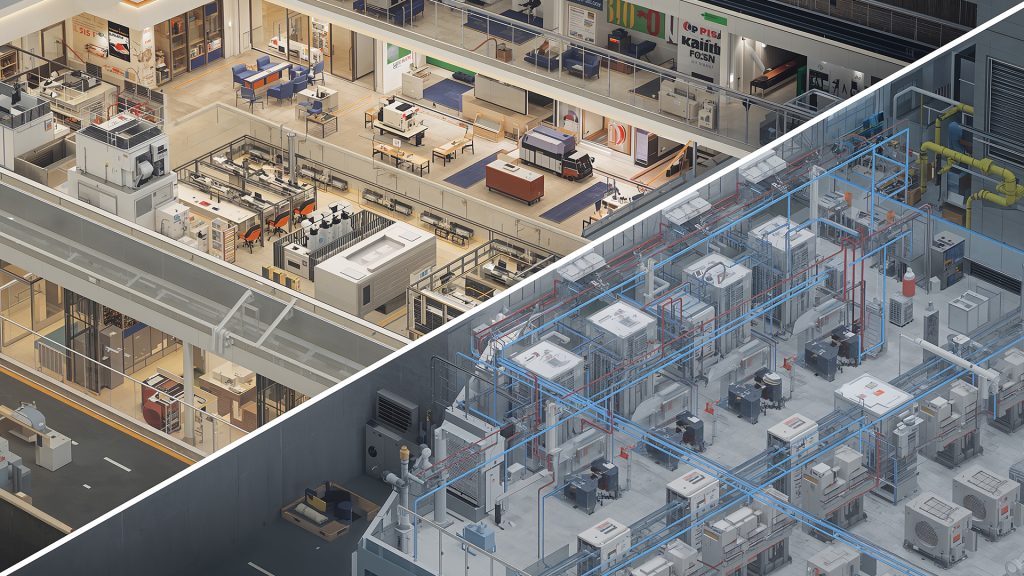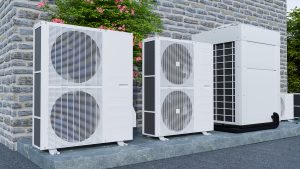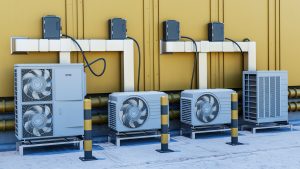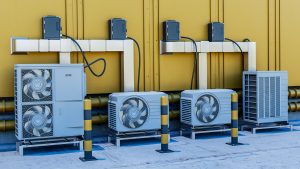Table of Contents
ToggleThe Difference Between VRF and AHU for Modern Buildings
Choosing the right heating, ventilation, and air conditioning (HVAC) system is one of the most critical decisions for any large-scale building project. Whether for a bustling shopping mall, a high-tech industrial facility, or a critical-care hospital, the HVAC system determines occupant comfort, operational efficiency, and long-term energy costs. At Workman Services, with over 18 years of experience in the HVAC & R industry, we guide our clients through this complex decision. Two of the most common solutions for large spaces are Variable Refrigerant Flow (VRF) and Air Handling Unit (AHU) systems. But what is the difference between VRF and AHU?
Understanding this distinction is key to selecting the ideal solution for your specific needs. While both systems deliver effective climate control, they operate on fundamentally different principles. An AHU-based system is a more traditional approach, using a central unit to condition air and distribute it through extensive ductwork. In contrast, a VRF system offers a more modern, decentralized approach, using refrigerant lines to connect a single outdoor unit to multiple indoor units.
This guide will explore the core concepts of both systems, break down their key differences, and explain which applications they are best suited for. By the end, you’ll have a clear understanding of the difference between VRF and AHU and be better equipped to choose the right system for your commercial, industrial, or residential project in Pakistan.
What is an Air Handling Unit (AHU)?
An Air Handling Unit, or AHU, is a cornerstone of traditional centralized HVAC systems. Think of it as the “lungs” of a building. The AHU is a large metal box containing a blower, heating and cooling elements (coils), filters, sound attenuators, and dampers. Its primary function is to collect air from outside and inside the building, filter it, condition it to the desired temperature and humidity, and then distribute it throughout the space via a network of ducts.
AHUs are often paired with chillers (which supply cold water to the cooling coil) or boilers (which supply hot water or steam to the heating coil). This combination allows a single, powerful system to serve an entire building, from a multi-story office block to a large factory floor. The simplicity and power of AHUs have made them a go-to solution for decades, especially for large, open spaces where a uniform temperature is required.
These systems are robust and highly effective at moving large volumes of air, making them a common component in an HVAC system for industries that require consistent environmental conditions.
What is a Variable Refrigerant Flow (VRF) System?
Variable Refrigerant Flow, or VRF, represents one of the most significant advancements in the latest HVAC technology. Unlike the centralized, air-based approach of an AHU, a VRF system is a refrigerant-based, multi-split system. It consists of a single outdoor condensing unit connected via refrigerant piping to multiple indoor units, which can be of various types (e.g., wall-mounted, ceiling cassette, or concealed ducted units).
The “variable” in its name is the key to its efficiency. The system can vary the amount of refrigerant flowing to each individual indoor unit, allowing for precise temperature control in different zones. Some advanced VRF systems can even provide simultaneous heating and cooling, where heat extracted from a cooling zone is redirected to a zone that requires heating. This heat recovery feature makes VRF air conditioning incredibly energy-efficient.
Because VRF systems use small refrigerant pipes instead of bulky ductwork, they offer greater architectural flexibility and are easier to retrofit into existing buildings. This modularity and zoning capability make them an increasingly popular choice for applications where individual comfort control is a priority.
Key Differences: VRF vs. AHU
To truly grasp the difference between VRF and AHU, it helps to compare them across several key factors. Both systems have their place, but their suitability depends entirely on the project’s requirements, budget, and long-term goals.
|
Feature |
Air Handling Unit (AHU) System |
Variable Refrigerant Flow (VRF) System |
|---|---|---|
|
System Type |
Centralized, air-based system. Uses ductwork to distribute conditioned air. |
Decentralized, refrigerant-based system. Uses pipes to send refrigerant to multiple indoor units. |
|
Zoning |
Limited zoning capabilities. Best for uniform temperature across large, open spaces. |
Superior individual zone control. Each indoor unit can have a different setpoint. |
|
Energy Efficiency |
Generally less efficient due to thermal losses in ductwork and constant air volume. |
Highly energy-efficient due to variable speed compressors, zoning, and heat recovery options. |
|
Installation |
Requires significant space for the AHU and extensive ductwork, which can be complex to install. |
Less invasive installation with smaller refrigerant piping. Ideal for retrofitting older buildings. |
|
Flexibility |
Less flexible. Difficult to modify once the ductwork is in place. |
Highly flexible and scalable. Easy to add or reconfigure indoor units as needs change. |
|
Maintenance |
Centralized maintenance at the AHU. Ductwork may require periodic cleaning. |
Requires specialized technicians to service multiple indoor and outdoor units and refrigerant lines. |
|
Upfront Cost |
Can have a lower initial equipment cost, but installation can be expensive. |
Higher initial equipment cost, but often lower installation and long-term operational costs. |
|
Ventilation |
Excellent for introducing fresh air, as it is integrated into the central unit. |
Requires a separate dedicated outdoor air system (DOAS) to introduce fresh air. |
Which System is Right for Your Application?
Now that we understand the technical difference between VRF and AHU, let’s apply this knowledge to real-world scenarios that we at Workman Services encounter daily.
HVAC for Malls and Retail Spaces
Shopping malls present a unique challenge with their mix of large open atriums, smaller individual retail stores, and food courts. An effective HVAC for malls needs to be both powerful and flexible.
- AHU Approach: A traditional approach might use large AHUs to cool the main corridors and open spaces. While effective for these areas, it offers little control for individual tenants, who often have to install their own supplementary systems.
- VRF Approach: A VRF air conditioning system is often a superior solution for modern malls. It allows each retail unit to control its own temperature, catering to varying occupancy levels and heat loads from lighting and equipment. The central mall management can still control the climate in common areas, but tenants gain the autonomy they desire. This targeted cooling makes it a more energy-efficient HVAC for malls.
HVAC System for Industries and Factories
The requirements for an HVAC system for industries vary widely depending on the processes involved. Some facilities need uniform temperatures, while others have distinct zones with different needs.
- AHU Approach: For large, open manufacturing floors or warehouses where a consistent temperature is the main goal, a robust AHU system is an excellent choice. It can move massive volumes of air and is built to withstand demanding industrial environments. Proper filtration within the AHU is also critical for maintaining air quality in dusty or contaminated environments.
- VRF Approach: In an industrial setting with separate offices, control rooms, and production areas, a VRF system offers distinct advantages. It can provide comfortable air conditioning in administrative wings while delivering a different temperature profile to sensitive manufacturing zones. For industries looking to adopt the latest HVAC technology for energy savings, VRF is a compelling option.
HVAC for Hospitals and Healthcare Facilities
Hospitals have some of the most stringent HVAC requirements. They need precise temperature control, high levels of filtration to prevent the spread of airborne pathogens, and extreme reliability.
- AHU Approach: AHUs have long been the standard for hospitals because of their superior ability to integrate high-efficiency particulate air (HEPA) filters and manage fresh air intake, which is crucial for infection control in operating rooms and patient wards. The centralized nature ensures consistent air quality management.
- VRF Approach: While VRF systems offer excellent temperature control for individual patient rooms, providing comfort and flexibility, they must be paired with a dedicated outdoor air system (DOAS) to meet the strict ventilation and air quality standards of healthcare. A hybrid approach, using the latest HVAC technology, often combines the strengths of both systems—AHUs for critical areas and VRF air conditioning for patient comfort zones.
The Final Verdict: Making the Right Choice with Workman Services
Ultimately, there is no single “best” system. The crucial difference between VRF and AHU lies in their operational strengths and how they align with a project’s specific needs.
An AHU-based system is the powerful, reliable workhorse ideal for large, open spaces requiring uniform cooling and high ventilation rates, such as factory floors, warehouses, and the core areas of hospitals.
A VRF system is the smart, flexible, and efficient choice for buildings with varied zones and occupancy, like modern offices, hotels, and retail centers. It provides unparalleled user control and significant long-term energy savings, making it an excellent investment in an effective HVAC for malls and other commercial properties.
At Workman Services, we don’t just sell products; we deliver tailored cooling and air distribution solutions. Our experienced team of designers and engineers will work with you to analyze your building’s layout, usage patterns, and budget. We will help you select the right system—whether it’s a robust AHU, a state-of-the-art VRF system, or a hybrid solution that provides the best of both worlds.
Frequently Asked Questions (FAQ)
1. Is VRF better than a traditional AHU with chillers?
“Better” depends on the application. VRF is typically more energy-efficient and offers better zone control, making it ideal for buildings with diverse loads like offices or hotels. An AHU/chiller system can be more effective for large, monolithic spaces and provides better central ventilation.
2. Can a VRF system provide fresh air?
A standard VRF system primarily recirculates and conditions the air within a space. To meet ventilation requirements, it must be paired with a separate system, such as a Dedicated Outdoor Air System (DOAS) or an Energy Recovery Ventilator (ERV), which introduces fresh, filtered air from the outside.
3. What is the lifespan of a VRF system versus an AHU?
Both systems are designed for longevity. A well-maintained commercial AHU can last 20-25 years or more. A VRF system typically has a lifespan of 15-20 years. Lifespan depends heavily on the quality of installation, regular maintenance, and operating conditions.
4. Which system is more expensive?
Generally, VRF systems have a higher upfront equipment cost than AHU systems. However, VRF often has lower installation costs due to the absence of extensive ductwork. Over the long term, the superior energy efficiency of VRF can lead to a lower total cost of ownership.
5. Why is Workman Services the right partner for choosing an HVAC system?
With over 18 years specializing in HVAC&R, Workman Services offers end-to-end solutions, from design and supply to installation and maintenance. We partner with leading brands like Midea, Gree, and Hitachi to provide the best HVAC system for industries, commercial buildings, and hospitals across Pakistan. Our commitment is to quality, efficiency, and complete client satisfaction.







